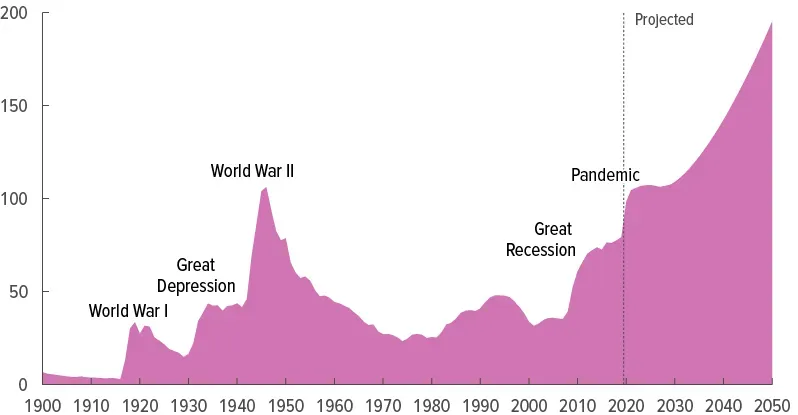The US Debt Clock is a dynamic, ever-ticking numerical marvel, a testament to one of the most pressing economic concerns of our era. It transcends mere digits and figures; instead, it encapsulates the pulsating fiscal heartbeat of the United States, bearing the immense weight of its financial decisions and obligations. Within this blog post, we delve into the profound significance of the US Debt Clock, illuminating its pivotal role as a real-time barometer of the nation's economic well-being.
Â
Introduction to US Debt Clock
In the intricate tapestry of a nation's economy, the US Debt Clock stands as a beacon of financial transparency and accountability. Serving as a real-time, ever-evolving display of the United States' national debt, it symbolizes the economic heartbeat of the nation. Much like a pivotal gauge, it measures and showcases the financial responsibilities and obligations undertaken by the government.
The significance of the US Debt Clock lies in its ability to present a stark and live portrayal of the nation's debt situation, conveying the magnitude and pace at which the debt accumulates. This numerical representation encapsulates the fiscal health of the country, serving as a stark reminder of the financial challenges faced. Every second, the numbers shift, illustrating the relentless increase in the national debt and providing a visceral realization of the fiscal decisions made in the halls of government.
Â
Understanding the National Debt
Â
Definition and Composition
The National Debt represents the total amount of money that the federal government of the United States owes to creditors. It is essentially a cumulative measure of all outstanding borrowings and obligations incurred to fund various governmental expenditures. This debt is comprised of two primary components:
Public Debt: This portion includes the debt held by individuals, institutions, foreign governments, and various financial entities outside the federal government. Public Debt frequently takes different forms such as government bonds, notes, and Treasury bills.
Intragovernmental Debt: Intragovernmental debt consists of money borrowed by the federal government from its agencies and trust funds, such as the Social Security Trust Fund. These funds essentially lend their surpluses to the government.
Â
Historical Background of the US National Debt
The origins of the National Debt trace back to the early days of the United States, as the nation struggled to establish its financial footing. In the wake of the Revolutionary War, the nascent nation found itself encumbered with substantial fiscal obligations, compelling the federal government to shoulder its inaugural financial responsibilities.

Source:Â Congressional Budget Office
Throughout its existence, the National Debt has undergone undulating fluctuations, propelled by a myriad of influences, spanning from armed conflicts and economic convulsions to governmental policies. Momentous turning points in history encompass the accumulation of debt during the Civil War and the financial backing of both World War I and World War II. In the post-war era, this debt continued its ascent, though at varying rates.
In modern times, the National Debt has ascended to unparalleled heights, surmounting a staggering $32 trillion. This disconcerting figure has seized the attention of economists, policymakers, and the general populace alike. To comprehend the broader economic challenges and opportunities confronting the nation, it becomes imperative to grasp its historical backdrop and intricate composition.
Â
Factors Influencing National Debt Growth
Â
Government Spending and Revenue Generation
Government spending is a significant driver of the National Debt. When expenditures exceed revenue, the deficit accumulates, necessitating borrowing to cover the shortfall. Key components include:
Entitlement Programs: Mandatory spending on programs like Social Security, Medicare, and Medicaid contributes to a substantial portion of government outlays.
Defense and Security: National security expenditures, including defense and intelligence, also influence the debt's growth.
Interest Payments: Interest on the existing debt is another substantial expense, and the debt's size impacts these payments.
Revenue generation, through taxes and other sources, plays a pivotal role in managing the debt. Economic growth and tax policies can affect the government's ability to generate revenue to offset expenditures.
Â
Economic Cycles and Recessions
The National Debt experiences significant fluctuations due to economic cycles, which are characterized by alternating periods of expansion and contraction. In times of economic downturns and recessions, government revenues typically dwindle owing to reduced tax collections and amplified expenditure on safety net programs. Consequently, this often leads to burgeoning deficits and an upward trajectory in the debt. Conversely, during phases of economic prosperity, governments may generate surpluses, contributing to a reduction in the overall debt burden.
Â
Impact of Major Events (Wars, Pandemics, Economic Crises)
Major events such as wars, pandemics, and economic crises can significantly impact the National Debt:
Wars: Financing wars, like World War I and II, required substantial borrowing, leading to debt expansion. Ongoing military conflicts can also strain fiscal resources.
Pandemics: Health crises, like the COVID-19 pandemic, can necessitate massive government expenditures on healthcare, economic relief, and stimulus packages, contributing to debt growth.
Economic Crises: Financial meltdowns, such as the Great Recession of 2008, can lead to bailouts and stimulus measures, further augmenting the debt.
Â
Functions of the US Debt Clock
Â
Tracking the National Debt In Real-Time
At its core, the US Debt Clock is a real-time ticker that continuously updates the total National Debt of the United States. This function allows users to witness the debt's constant evolution, providing a vivid snapshot of the nation's fiscal state. The clock considers all government borrowings, including those from public and intragovernmental sources. This real-time tracking offers several benefits:
Transparency: It promotes transparency in government finances by making debt data accessible to the public.
Accountability: The clock holds the government accountable for its fiscal decisions, as every expenditure and borrowing decision affects the displayed debt figure.
Educational Tool: It serves as an educational tool, helping individuals, economists, and policymakers understand the consequences of debt accumulation.
Â
Key Statistics Provided By the US Debt Clock
The US Debt Clock presents a multitude of essential data that offer priceless insights into the nation's current economic situation when digging into the complex world of financial affairs beyond the simple enumeration of the National Debt.
Federal Revenue: This figure represents the total income collected by the federal government from various sources, including taxes and other revenue streams.
Federal Spending: It showcases the total expenditures made by the government, including essential programs, services, and interest payments on the debt.
Budget Deficit: The difference between federal revenue and spending, which indicates whether the government is running a surplus or deficit.
Population: The clock displays the estimated population of the United States, giving context to debt per capita calculations.
Medicare and Social Security Liabilities: These figures highlight the unfunded liabilities associated with Medicare and Social Security, shedding light on future fiscal challenges.
These statistics collectively offer a comprehensive overview of the nation's financial position. They allow individuals and policymakers to gauge the sustainability of government finances and make informed decisions about fiscal policies, budgetary priorities, and personal financial planning.
Â
Real-Time US Debt Clock Analysis
Â
Interactive Features Explained
The US Debt Clock offers an array of interactive features that enhance its functionality, allowing users to delve deeper into the nation's fiscal landscape.
Debt Breakdown by Category: Users can interact with a pie chart illustrating the different components contributing to the national debt. This breakdown provides insights into the major sectors driving debt accumulation.
State Debt Information: The clock often includes state-specific debt information, enabling users to comprehend the debt burden at both the national and state levels.
Historical Data Display: Users can access historical data, comparing past debt figures to the current state, aiding in trend analysis, and understanding the trajectory of debt growth.
Real-Time Tickers: The clock offers real-time counters showcasing various financial metrics, including the National Debt, federal revenue, federal spending, and the budget deficit. This live updating functionality allows users to observe the debt's dynamic nature.
Â
Insight into Debt per Citizen and Per Taxpayer
Understanding these metrics is essential in comprehending the personal implications of the national debt. It allows individuals to contextualize their share of the debt and consider its impact on their financial planning and decision-making.
Debt per Citizen: This metric divides the total national debt by the estimated population, providing an average debt burden per individual. It offers a tangible perspective on the financial obligation each citizen theoretically holds concerning the national debt.
Debt per Taxpayer: Similar to debt per citizen, this metric calculates the debt burden per taxpayer, offering insights into the financial liability of taxpayers in the country.
Â
Comparative Analysis with Other Countries' Debt Clocks
By offering comparative insights, the US Debt Clock places the nation's debt situation in a broader global context, highlighting both unique challenges and shared economic realities.
Debt Clocks of Other Nations: The US Debt Clock frequently undertakes a comparative evaluation by showcasing statistics gleaned from the debt timepieces of other nations. This distinctive attribute empowers users to juxtapose the fiscal predicament of the United States against that of its global counterparts, thus imparting an international panorama.
Debt-to-GDP Ratios: Comparative analysis may include debt-to-GDP ratios, enabling users to assess the proportion of debt relative to the country's economic output. This comparison aids in understanding the country's debt sustainability.
Â
Controversies and Criticisms on the US Debt Clock
While the US Debt Clock serves as a valuable tool for transparency and public awareness, it's essential to recognize its limitations and the potential for it to become a focal point of political discourse and controversy. As with any financial data source, a critical and informed perspective is crucial for making sense of the complexities of national debt and its implications.
Â
Opinions on the Effectiveness of the US Debt Clock
Â
Efficacy as a Policy Tool: Some critics argue that the US Debt Clock, while informative, may not be an effective policy tool. They contend that it can oversimplify complex economic issues and may not influence meaningful policy change.
Fear-Mongering: Critics suggest that the constant display of rising debt numbers can contribute to fear and anxiety among the public, potentially influencing perceptions of economic stability.
Â
Accuracy and Reliability Concerns
Â
Data Sources: Questions have arisen about the sources of data used by the US Debt Clock. Some individuals have expressed doubts about the accuracy and timeliness of the data, which is crucial for an informed analysis.
Complex Economic Metrics: Critics argue that reducing the nation's economic health to a few numbers on a digital display oversimplifies the complexity of economic indicators and can lead to misunderstandings.
Â
Political and Ideological Debates Surrounding the Debt Clock
Â
Partisan Use: The US Debt Clock is often used by both political parties to support their arguments. Critics assert that this can lead to the selective use of data to advance specific political agendas.
Ideological Divides: Debates surrounding the National Debt often reveal stark ideological differences. Some argue that the debt clock fosters polarized discussions rather than constructive dialogue on fiscal policies.
Misleading Comparisons: Comparative data displayed on the debt clock can sometimes be misinterpreted or used to make misleading international comparisons, fueling political debates on fiscal responsibility.
Â
Exploring the Implications of National Debt
Comprehending these implications stands as an imperative task for policymakers, economists, and the populace in general. The National Debt emerges as a convoluted quandary, bearing myriad ramifications capable of sculpting the economic terrain and leaving an indelible mark on the prosperity of forthcoming generations.
Â
Impact on the Economy and Job Market
Â
Interest Payments: The National Debt's continuous growth leads to escalating interest payments, consuming a significant share of government spending. This strains available resources for crucial programs like infrastructure, education, and healthcare. The debt's insatiable demand resembles a relentless predator, affecting various facets of our society. This fiscal challenge necessitates careful management to ensure sustainable economic growth.
Crowding Out Effect: When government borrowing competes fiercely with private sector borrowing for the limited pool of accessible funds, high levels of debt can lead to the crowding-out effect. The pressure this sets on interest rates forces them to rise, causing it pricier for firms to invest and create jobs.
Economic Growth: Excessive debt can impede economic expansion by diverting funds from profitable projects. Additionally, it retains the potential to diminish trust in the economy's overall resilience, which could have a consequence on how consumers and firms act.
Â
Effects on Future Generations
Â
Burdens for Future Generations: The accumulation of a substantial National Debt has the potential to transfer onerous financial burdens to future generations. These descendants may find themselves inheriting an economy encumbered by debt, a situation that could precipitate increased taxation, diminished government services, or perhaps both.
Reduced Fiscal Flexibility: High levels of debt can limit the government's ability to respond to future crises or invest in long-term priorities, as a significant portion of revenue is allocated to servicing the debt.
Â
Relationship between National Debt and Inflation
Â
Inflationary Pressure: The ongoing debate centers on the complex relationship between national debt and inflation. Some argue that excessive debt could trigger inflation if the government resorts to unchecked money printing to meet its obligations, while others contend that this link is intricate and influenced by various factors. Ultimately, the discussion underscores the nuanced nature of the connection between these economic phenomena.
Expectations and Confidence: Inflation can be influenced by public expectations and confidence in the government's ability to manage its finances. A high level of confidence can mitigate inflationary pressures associated with debt.
Â
Public Perception and Awareness of US Debt Clock Ticking
Enhancing public awareness and fostering a deeper comprehension of the US Debt Clock transcends mere fiscal accountability; it stands as a pivotal pillar in upholding a populace that is not only well-informed but also profoundly engaged. A knowledgeable citizenry possesses the potential to catalyze more proficient governance, heightened transparency, and enhanced fiscal decision-making, spanning the realms of both individual and governmental spheres.
Â
Importance of Citizen Awareness
Â
Informed Decision-Making: An informed citizenry is the cornerstone of a thriving democracy. Understanding the implications of the National Debt empowers individuals to make informed decisions about their finances and exert influence on government fiscal policies through their voting choices and civic engagement.
Accountability: Public awareness of the National Debt holds elected officials accountable for their fiscal decisions. When citizens are informed about the debt's size and trajectory, they can demand transparency and responsible fiscal stewardship from their representatives.
Â
Media Coverage and Public Discourse
Â
Media as a Bridge: The media plays a pivotal role in bridging the gap between complex economic data and public understanding. Extensive media coverage of the US Debt Clock ensures that the topic remains in the public discourse.
Sparking Dialogue: Public discourse on the National Debt, often spurred by media coverage, can lead to constructive debates about fiscal priorities, tax policies, government spending, and long-term economic planning.
Political Considerations: The National Debt can become a focal point in political campaigns, debates, and discussions, shaping public opinion on candidates and influencing electoral outcomes.
Â
Educational Initiatives and Public Outreach Efforts
Â
Financial Literacy: Educational endeavors possess the potential to nurture financial literacy and enrich the general populace's comprehension of the ramifications of the National Debt. Educational institutions such as schools, universities, and community organizations can actively contribute by furnishing valuable resources and disseminating essential information.
Government Transparency: Government agencies and organizations can engage in public outreach efforts to explain the intricacies of government finances and how the National Debt impacts citizens' lives.
Debt Reduction Strategies: Public awareness can also drive support for debt reduction strategies and fiscal policies aimed at addressing the National Debt.
Â
Role of Individuals in Addressing the Debt
Addressing the National Debt is a collective effort that extends beyond the government's responsibility. It requires active involvement from citizens who should take personal financial responsibility, engage in civic processes, and grasp the long-term consequences of debt. By doing so, individuals can play a crucial role in shaping a more fiscally responsible future for the nation.
Â
Personal Financial Responsibility
Â
Budgeting and Saving: Managing personal finances responsibly can indirectly contribute to addressing the National Debt. By living within their means, saving, and avoiding excessive debt, individuals can reduce their reliance on government support programs and contribute to a healthier economy.
Advocating for Fiscal Responsibility: Informed citizens possess the ability to champion fiscal responsibility at the government level. They can actively endorse policies that advocate for prudent expenditure, the maintenance of balanced budgets, and the long-term reduction of debt burdens.
Â
Civic Engagement and Influencing Policy-Makers
Â
Voting and Participating: One of the most direct ways individuals can influence government fiscal policies is by participating in the democratic process. Voting for candidates who prioritize fiscal responsibility and engaging in advocacy campaigns can make a difference.
Contacting Representatives: Communicating with elected representatives and policymakers to express concerns and opinions on fiscal matters can have a significant impact. Letters, emails, and phone calls are effective ways to make your voice heard.
Joining Civic Organizations: Getting involved in civic organizations dedicated to fiscal responsibility can amplify individual efforts. These organizations often have resources and platforms for advocating for prudent fiscal policies.
Â
Understanding the Long-Term Consequences
Â
Educating Oneself: To be effective advocates for fiscal responsibility, individuals should educate themselves about the long-term consequences of the National Debt. This includes understanding the economic impact, potential tax implications, and the burden it places on future generations.
Raising Awareness: Sharing knowledge and information about the National Debt with friends, family, and social networks can raise awareness and spark discussions. This can contribute to a more informed citizenry.
Supporting Sustainable Solutions: Individuals can support policies and initiatives that offer sustainable solutions to address the National Debt. This might include measures aimed at reducing budget deficits, controlling spending, or reforming entitlement programs.
Â
Role of Government and Policy-making for Debt Reduction
Government and policy-making for debt reduction require a delicate balance between fiscal responsibility, economic growth, and addressing the needs of the population. Crafting effective strategies, fostering constructive debates, and navigating the complex political landscape are essential for successfully reducing the National Debt and securing a sustainable fiscal future.
Â
Strategies for Debt Reduction
Â
Balanced Budgets: Governments can strive for balanced budgets, where revenues match or exceed expenditures. This helps prevent the accumulation of new debt and gradually reduces existing debt over time.
Fiscal Reforms: Implementing fiscal reforms that streamline government operations, improve tax systems, and optimize public expenditures can enhance revenue streams and reduce wasteful spending.
Debt Restructuring: Governments can negotiate with creditors to restructure existing debt, potentially securing more favorable terms, lower interest rates, or extended repayment periods to ease the debt burden.
Economic Growth Policies: Promoting policies that stimulate economic growth, such as infrastructure investments, innovation incentives, and support for small businesses, can boost tax revenue and reduce debt relative to the size of the economy.
Â
Debates on Fiscal Responsibility
Â
Taxation Policies: The ongoing debate centers on taxation, with some advocating for higher taxes to boost revenue, while others argue for lower taxes to spur economic growth. This crest underscores the complicated and multifaceted nature of the taxation matter.
Social Programs and Entitlements: Navigating the intricate terrain of balancing social programs and entitlements while upholding fiscal responsibility remains a profound subject of debate. The challenge lies in harmonizing the provision of essential services with the artful management of their associated costs.
Defense Spending: The allocation of resources to defense and security versus other priorities is a debated topic. Evaluating the necessity and efficiency of defense spending is crucial in debt reduction strategies.
Â
Political Challenges and Decision-Making Processes
Â
Partisan Differences: In the complex arena of politics, diverse opinions within parties about fiscal policy complicate the quest for a consensus on debt reduction strategies. The pressing need is to discover shared ground and promote bipartisan collaboration, a formidable and essential undertaking.
Short-Term vs. Long-Term Priorities: In the field of politics, the cyclic nature of governance can sometimes steer the focus towards short-term gains at the expense of long-term fiscal responsibility. The persistent challenge lies in fostering a transition towards a mindset that prioritizes long-term planning and sustains policies for the future.
Public Opinion and Pressure Groups: Political decisions are influenced by public opinion and pressure from interest groups. Balancing public demands with fiscal prudence is a delicate task for policymakers.
Â
Future Scenarios and Projections
The decisions taken by our leaders, the constantly changing economic environment, and the engaged participation of our population will determine the path the US national debt will take in the coming years. A combination of wise fiscal policies, initiatives to promote economic growth, and responsible governance are required to effectively address the debt conundrum.
Â
Forecasting the Trajectory of the US National Debt
Forecasting the path of the national debt in the United States presents a daunting challenge, given the myriad of factors in play. These factors encompass economic fluctuations, government policies, and unanticipated events. Despite this complexity, there are countless hypothetical scenarios to ponder:
Current Path: If current fiscal policies remain unchanged, the debt is projected to continue growing, potentially reaching unprecedented levels as a percentage of GDP.
Reform Scenario: If policymakers implement significant fiscal reforms, such as reducing entitlement spending, increasing revenue through tax reform, and controlling discretionary spending, the debt growth rate may slow down.
Economic Events: Unforeseen events, such as financial crises or major recessions, can significantly impact the trajectory of the debt, potentially leading to rapid increases.
Â
Potential Consequences of Unsustainable Debt Levels
Â
Interest Costs: When we delve into the realm of accumulating debt, we must bear in mind the concomitant escalation in interest payments. This heightened burden of burgeoning interest costs possesses the latent capacity to obstruct pivotal government endeavors, potentially culminating in diminished allocations for imperative sectors such as infrastructure, education, and healthcare.
Inflation: Excessive debt can create inflationary pressures, eroding the purchasing power of citizens and negatively impacting savings and fixed incomes.
Economic Instability: Unsustainable debt levels can lead to economic instability, affecting investor confidence, financial markets, and job creation.
Reduced Policy Flexibility: A high debt burden limits the government's ability to respond to economic downturns or unexpected crises, potentially amplifying the impact of such events.
Â
Possible Strategies and Solutions
Â
Fiscal Reforms: Implementing comprehensive fiscal reforms, including reducing discretionary spending, addressing entitlements, and modernizing the tax system, can help put the debt on a more sustainable path.
Economic Growth Initiatives: Promoting policies that support economic growth, such as infrastructure investments, research and development incentives, and trade expansion, can boost government revenue and reduce the relative size of the debt.
Debt Restructuring: Exploring options for debt restructuring, including negotiating more favorable terms with creditors, can help ease the debt burden.
Budgetary Discipline: Enforcing budgetary discipline through mechanisms like statutory spending caps and fiscal rules can encourage responsible spending and prevent excessive deficits.
Public Awareness and Engagement: Increasing public awareness of the National Debt and engaging citizens in discussions about fiscal responsibility can exert pressure on policymakers to take action.
Â
Final Thoughts
In this comprehensive exploration of the US National Debt and the role of the US Debt Clock, several key insights and critical considerations emerge. The US Debt Clock serves as a real-time beacon of the nation's fiscal health, tracking government spending, revenue, and key statistics. However, it also stirs controversies, with debates about its effectiveness as a policy tool and concerns about accuracy, as it becomes a focal point for political and ideological disputes.
Â
FAQs
What is the current US national debt?
In the sultry August of 2023, the United States grappled with a daunting national debt, an astonishing 32.91 trillion U.S. dollars, marking an unprecedented surge of nearly two trillion dollars when juxtaposed with the prior year's sum, which hovered around 30.94 trillion U.S. dollars.
Â
How does the US Debt Clock work?
The US Debt Clock is a real-time display showing various economic statistics, including the national debt, government revenue, and expenditures. It calculates these figures based on formulas and publicly available data to provide up-to-date insights into the nation's financial situation.
Â
Can the US national debt ever be fully repaid?
It's highly unlikely for the US to fully repay its national debt. Historically, nations often manage their debt through a combination of economic growth, responsible fiscal policies, and refinancing rather than outright repayment.
Â
What are the potential risks of a continuously increasing national debt?
Continuously increasing national debt can lead to higher interest payments, crowding out other essential government expenditures, potential inflation, reduced fiscal flexibility, and long-term economic instability.
Â
How can I contribute to reducing the national debt as an individual citizen?
As an individual, you can contribute by advocating for responsible fiscal policies, supporting politicians committed to debt reduction, staying informed, and managing your finances responsibly to reduce reliance on government services.
Â
How does the US national debt affect the average American citizen?
The national debt can impact citizens through potential tax increases, reduced government services, inflation affecting purchasing power, and uncertainty about future economic stability.
Â
Is the US national debt a threat to national security?
In the grand tapestry of concerns, an imminent peril might not be evident, yet an exorbitantly elevated national debt has the potential to cast a shadow upon our national security. It does so by constricting the reservoir of governmental resources allocated to fortification and other pivotal domains.
Â
What measures are in place to prevent a debt crisis?
Measures include periodic reviews and adjustments of fiscal policies, setting debt ceilings, implementing budgetary discipline, and encouraging responsible borrowing and spending.
Â
Are there any successful examples of countries effectively reducing their national debt?
Yes, countries like Canada, Australia, and New Zealand have successfully reduced their national debt through a combination of prudent fiscal management, economic growth, and targeted policies.
Â
How does the US national debt impact other countries?
The US national debt can influence global markets, interest rates, and international investments. Its stability and management have implications for the global economy and other nations holding US debt.



